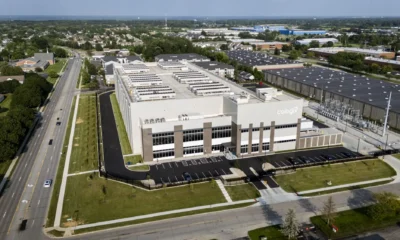Business
Meet the companies using AI to reinvent the energy business

The rise of artificial intelligence has created an energy paradox. While tech leaders behind AI tools like ChatGPT say large language models can solve some of the world’s biggest problems, the infrastructure powering the technology may be creating another problem as a result of the environmental impact. AI data centers can consume 20 to 30 times as much energy as their CPU-based predecessors, according to Mark Chung, CEO of energy efficiency monitoring company Verdigris. Some experts predict AI will account for more than 10% of U.S. electricity consumption within five years, fueling fears that unchecked AI compute demand could exponentially accelerate climate damage.
But the convergence of AI and energy is also forcing a rethink of the industry’s traditional practices, creating opportunities to mitigate the environmental impact by making the grid, and the data centers it feeds, operate more cleanly and more efficiently than was possible before.
“One of the biggest challenges with providing energy to a data center is optimizing the flow of that energy, and that is a problem that AI can be extremely helpful in solving,” says Katie Durham, a partner at Climate Capital.
One of the largest players using AI to tackle this efficiency problem is Kraken Technologies. Its AI-powered operating system serves over 70 million customer accounts across 40 utilities worldwide. It connects more than 500,000 consumer devices—from EV chargers to home batteries—and controls over five gigawatts of flexible energy supply, offsetting 14 million tons of CO₂ in 2024 alone, according to figures shared with Fortune.
Devrim Celal, Kraken’s chief marketing and flexibility officer, said the company’s success hinges on finding efficiencies in renewable energy demand. “When you transition to renewable energy, you get a completely new set of problems,” he says, explaining the company’s role in analyzing the demand for renewables to create a system that stores or deploys energy based on user-specific consumption patterns.
He also notes that the company uses machine learning to cluster consumers based on their energy consumption patterns and efficiently distribute renewable power with 90% accuracy. This means that if a customer typically charges their electric vehicle to 100% from 9 p.m. to 7 a.m. every day, the energy will be deployed at this time and reserved when the vehicle is away from home. “That’s incredibly powerful when balancing the grid,” he says.
Miami-based Exowatt is building solar energy systems designed to power AI data centers around the clock. By providing a means to store and dispatch solar power at any time of day, the company helps utilities deal with the inherent intermittency of solar without resorting to carbon-emitting energy sources, says Exowatt CEO and cofounder Hannan Happi. “We’re really in a mad rush to bring the product to market and scale it as fast as possible,” he notes. “Because if we don’t, the only energy and power solution data center customers have available to them is just putting diesel and natural gas on the grid, which is really, really affecting the communities around where these data centers are being built.”
Exowatt is also leaning heavily on AI internally. It uses LLMs to power a “digital twin” system that simulates performance in real time and enables proactive maintenance. The company is replacing traditional SaaS tools with custom-built AI software, tailored to its supply-chain and manufacturing needs.
Halcyon, a startup with $10.8 million in seed funding, is using AI to help energy professionals in a different way. The firm has created large language models that ingest regulatory filings from agencies like the Federal Energy Regulatory Commission and the Department of Energy and makes them searchable and structured—saving energy developers time and expanding access to up-to-date data on battery incentives, grid constraints, and transmission plans.
“We’re using LLMs primarily to read,” says Sam Steyer, head of data science at Halcyon. “We think of the regulatory analyst at an energy company who, in the past, would have to search for the right 1,000 page PDF and then use Control F and maybe spend a day finding the right piece of data … We’re trying to make that process as efficient and fast as possible and empower that person to do the same work at a much bigger scale.”
A part of Halcyon’s mission is to ensure that AI’s expanding appetite for electricity also accelerates the clean energy transition. The company is building trackers for special data center electricity rates and tools that help renewable developers site projects faster.
“AI and energy are really symbiotic,” says Steyer. “AI is driving growth in electricity demand in a big way … It’s going to be completely essential to scaling the electricity system.”
Business
Cost of living giveaway event at Withernsea Leisure Centre

Residents struggling with the cost of living will be able to access free gifts and affordable produce at a community event in Withernsea.
East Riding of Yorkshire Council said its Help for Households drop-in event would also offer advice on saving money and staying warm.
The event is being held at the town’s leisure centre on Wednesday 25 September, from 10:00 BST to 15:00.
Councillor Nigel Wilkinson, the authority’s cabinet member for finance and governance, said: “We’re aware that many people across the East Riding are struggling with the ongoing cost of living crisis and are making active efforts to support those in need.”
The council said people could get advice on schemes available to help with heating costs ahead of autumn and winter, while eligible households can also get help with loft and cavity wall insulation.
The authority also said there would be affordable produce available to buy, a heated gilet giveaway and free SIM cards and mobile data.
There will also be advice on benefits available to residents on how to reduce bills.
Wilkinson added: “The council has already helped local residents to claim more than £3.8m in benefits in the past year.
”We highly encourage interested residents in Withernsea to attend the drop-in event and find out more about the support for which they may be eligible.”
Residents unable to attend can learn more about the support schemes available by contacting the council.
Business
Scotland scrapped peak rail fares

Mitchell LabiakBusiness reporter, BBC News
 Getty Images
Getty ImagesTrain passengers no longer have to pay higher prices for peak time tickets on ScotRail, raising the question over whether the rest of the UK could follow suit.
While some passengers told the BBC they would welcome the prospect of cheaper tickets, experts are divided over whether it could push prices up overall or result in overcrowded carriages.
Why do we have peak times?
The peak/off-peak system is designed to discourage passengers from getting on busier trains, by making it more expensive to travel during the commuter rush before 9am and between 5pm and 7pm.
However, the pandemic working from home and rail usage has not yet returned to pre-Covid levels so peak travel times are less busy than they used to be.
David Ross, chief operating officer at ScotRail, told Radio 4’s Today programme that this shift meant it could scrap peak charges as “there’s plenty of capacity for people to travel with us”.
Could peak charges be scrapped in the rest of the UK?
Unlike the Scottish system, English railways are run by a mix of publicly-owned firms and private contractors which the government has pledged to nationalise as their contracts end.
Ticket prices are set by the Department for Transport (DfT) so if the government wanted to scrap peak fares across England it could.
London North Eastern Railway (LNER), which is run by the government, is experimenting with the removal of off-peak charges across parts of its network – with the pilot due to end on 7 September.
The DfT has not said whether or not it would try removing off-peak charges across the whole English network, but it has said it wants to reform the way tickets are priced as it nationalises the system.
“We know the current labyrinth of fares and prices can be confusing, which is why we want to make it easier for passengers to find the right ticket for their journey,” a transport spokesperson said.
Meanwhile, Transport for Wales (TfW) and Translink operate the Welsh and Northern Irish railways and are run by their devolved governments.
The BBC has approached both TfW and Translink for comment.
Would it make ticket prices cheaper?
ScotRail’s move has reduced prices – an anytime day return ticket from Glasgow to Edinburgh has gone from £32.60 to £16.80.
ScotRail’s Ross said this means “passenger journeys will increase and over time it will pay for itself”, but rail experts are divided.
If passenger numbers remain the same ticket prices may need to go up overall to make up for the lost revenue, some have warned.
The other issue is what scrapping off-peak would mean for some already overcrowded routes.
“Clearly, the rush hour trains are already packed. And if you remove the disincentive to travel, it would mean more would want to travel on those trains,” said Bruce Williamson from campaign group Railfuture.
As such, he said any removal of peak charges would need to come alongside investment in increasing capacity of the rail network – something which would cost the government money.
‘I can’t afford to travel during peak times’

Elizabeth Wilson, 18, from Hull, is due to start a maths degree course at Newcastle University and believes ScotRail’s initiative should be “standard across the whole of the country”.
“There shouldn’t be a difference in price just because of when you travel. At the end of the day you’re doing the same journey, it shouldn’t matter what time you do that journey.”
Elizabeth says even with her 16-25 railcard “train fares are really expensive especially for students who don’t have much money”.
“I’m often having to wait until later so I can travel because I can’t afford to travel during peak times,” she adds.
She says the current cost of rail fares mean “you’re almost forced to buy a car because it’s much easier”.

Kara Smith, 23, from Leeds, works at Selfridges in Manchester and says she mainly drives to work because the peak time commute was “very expensive”.
“I used to see most of my wages going on train fares,” she says.
“I’d use the train more often if the fares were cheaper as it’s more convenient. But because of the prices it just makes more sense to drive.”

Mariama Bundu is from Newport in south Wales says she tends to travel at peak times and found the price “ridiculous”.
She spoke to the BBC at Paddington station in London where she was changing trains, having spent almost £200 on a return journey from Newport to Cambridge.
“Sometimes, I have to travel in first class because it’s difficult to get seats [in standard class during peak times],” she added.
Additional reporting by Pritti Mistry, Simon Browning and Emer Moreau
Business
Starmer cannot have armoured electric Range Rover ‘because of bomb risk’ | Jaguar Land Rover

Would-be car buyers considering ditching petrol for electric tend to fret – not always correctly – about higher upfront costs, access to chargers and whether their battery will last on long journeys.
But Keir Starmer has an unusual obstacle to making the switch – Britain’s largest carmaker has claimed electric vehicles (EVs) do not offer adequate bomb protection.
The prime minister’s armoured Range Rover Sentinels will need to remain as petrol versions for the foreseeable future, according to their manufacturer, Jaguar Land Rover.
JLR addressed the issue in written responses to a government consultation on EV sales rules. The documents – obtained by Fast Charge, a newsletter covering electric cars, and shared with the Guardian – detailed how JLR and other carmakers lobbied the UK government to weaken targets requiring them to sell more EVs each year.
JLR said armoured cars should be excluded from the targets, known as the zero emission vehicle mandate, because it “does not see any workable engineering solution to the challenges surrounding an armoured BEV [battery EV], primarily because the required safety levels and blast protection cannot be achieved”.
Armoured vehicles are a small but very profitable business for carmakers. They usually have bulletproof glass, armour plating, and “bomb blankets” under the floor, adding hundreds of kilograms of weight to already heavy cars.
It is unclear what specific vulnerabilities the maker of Jaguar and Land Rover cars sees in armoured electric vehicles, although potential issues could include the reduction in range from the extra weight and the time needed to recharge.
However, its German rival BMW does not appear to share those worries: its electric i7 Protection saloon offers “special armouring” in the floor and ceiling to protect against explosives on the ground and those carried by drones.
JLR said the UK government was the main customer in Britain for its armoured vehicles. The vehicles are built at the company’s site at Solihull in the West Midlands and then converted by its special vehicle operations department.
Precise specifications of Starmer’s fleet of Range Rover Sentinels are not public to avoid aiding potential attackers, but they are understood to have 5-litre V8 engines, designed to allow the heavy cars to speed off if threatened.
The prime ministerial fleet also includes non-electric, German-made armoured Audi A8 saloon cars, which replaced the Jaguar XJ after that model was discontinued.
after newsletter promotion
Tom Riley, the author of the Fast Charge newsletter, said: “This is the first time I’ve come across ‘blast anxiety’ as an excuse not to switch. Clearly, it’s a valid concern, but it does mean the prime minister could be the last Brit to go electric.”
For motorists who do not need to worry about bomb attacks, overall lifetime costs for electric cars are significantly lower on average, while “range anxiety” should not be a problem for those who rarely make journeys longer than 200 miles and live in places where charging facilities are increasingly common, such as the UK, western Europe or parts of the US.
JLR declined to comment.
-

 Business3 days ago
Business3 days agoThe Guardian view on Trump and the Fed: independence is no substitute for accountability | Editorial
-
Tools & Platforms3 weeks ago
Building Trust in Military AI Starts with Opening the Black Box – War on the Rocks
-

 Ethics & Policy1 month ago
Ethics & Policy1 month agoSDAIA Supports Saudi Arabia’s Leadership in Shaping Global AI Ethics, Policy, and Research – وكالة الأنباء السعودية
-

 Events & Conferences3 months ago
Events & Conferences3 months agoJourney to 1000 models: Scaling Instagram’s recommendation system
-

 Jobs & Careers2 months ago
Jobs & Careers2 months agoMumbai-based Perplexity Alternative Has 60k+ Users Without Funding
-

 Funding & Business2 months ago
Funding & Business2 months agoKayak and Expedia race to build AI travel agents that turn social posts into itineraries
-

 Education2 months ago
Education2 months agoVEX Robotics launches AI-powered classroom robotics system
-

 Podcasts & Talks2 months ago
Podcasts & Talks2 months agoHappy 4th of July! 🎆 Made with Veo 3 in Gemini
-

 Podcasts & Talks2 months ago
Podcasts & Talks2 months agoOpenAI 🤝 @teamganassi
-

 Mergers & Acquisitions2 months ago
Mergers & Acquisitions2 months agoDonald Trump suggests US government review subsidies to Elon Musk’s companies






















